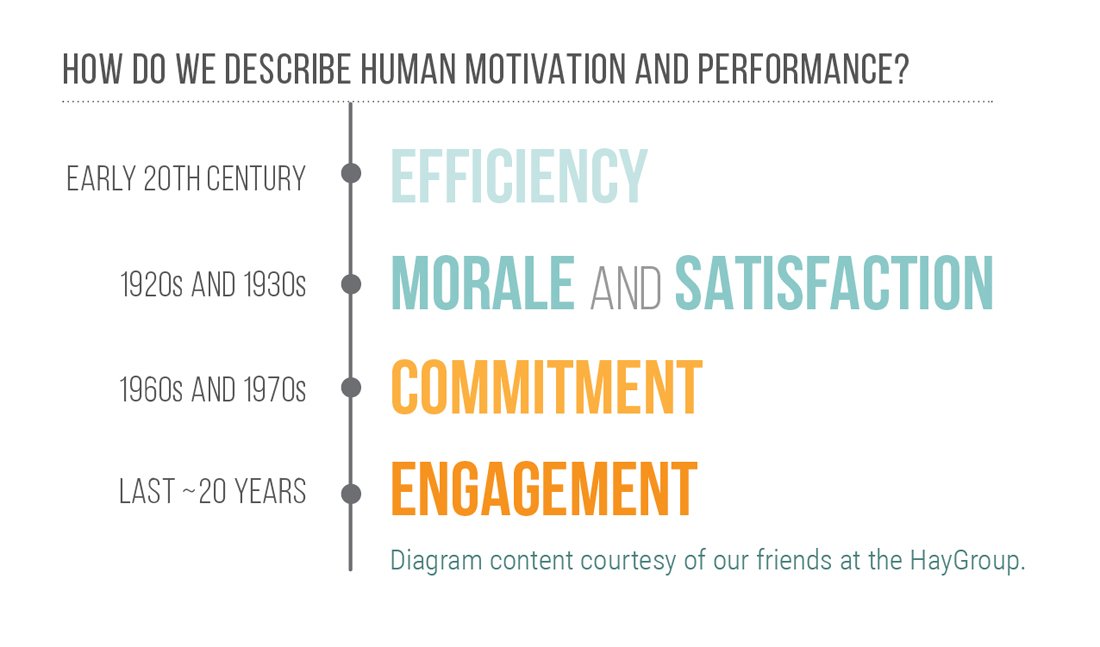The risks of ineffective employee engagement programs are too great for any organization to ignore. Gallup estimates disengaged employees cost U.S. businesses $450-550 billion annually.
The costs of disengaged employees come in the form of higher rates of error, absenteeism, and voluntary turnover, making disengagement just as harmful to your reputation as it is to your profits.
Establishing effective employee engagement programs and reaching out to disengaged employees is no small feat, especially considering only 32% of Americans feel engaged in their work. There’s no quick fix either; implementing comprehensive employee engagement programs can’t happen overnight, and it won’t immediately transform your workforce.
In times like this, it’s important to go back to basics, to seek new insights by consulting the past. As it turns out, the history of human resources still has lessons to teach us about building a better workplace.
The product-centric industrial era
History reveres Henry Ford for the way he revolutionized transportation with the Model T. The Model T was the first affordable family vehicle for many middle-class Americans when it was released to the public. Critical to Ford’s success was the installation of the world’s first moving assembly line into the vehicle’s production process in 1913. The assembly line dramatically cut production time down from 12 hours to just 90 minutes, enabling Ford to slash prices and reap greater sales.
Ford’s massive gains in productivity were impressive, but his methods were reflective of the product-centric ideology of his era. The assembly line moved the product through his workers in order to maximize production capacity, dehumanizing Ford’s employees as mere resources, or “cogs in the machine.” Ford was even forced to double his workers’ wages to curb the unexpected high turnover that resulted from the monotony of assembly line work. The experience of the individual was forsaken to make way for more product. Just fifteen years later, however, a more holistic, human-centric view of labor would emerge.
Related: 3 Tips to Make Employee Engagement Programs More Effective
The birth of the HR industry
Fast forward to 1928, Elton Mayo is studying productivity at Western Electric’s Hawthorne Works factory complex. While examining the effect of sunlight exposure on worker productivity, Mayo came across an unexpected discovery.
Mayo and his team observed boosts in productivity in both the presence and absence of sunlight. The team concluded the effects of the sunlight had no impact on the workers’ performance. Rather, it was the act of observing the workers that led to this boost in productivity. In his report, Mayo specifically asserted that the workers were responding to a perceived interest and sympathy from the research team.
Mayo and his team continued their studies on human performance in the workplace in a series that would later be known as the Hawthorne Experiments. In a letter to George Pennock, a Western Electric superintendent, Mayo summarized the results of the series, writing, “The change which you and your associates are working to effect will not be mechanical but humane.”
This sentiment—that increases in productivity come to organizations that commit to improving the welfare of their employees—was groundbreaking for the era, and effectively created the human resources profession.
Productivity and engagement
Mayo’s findings gave way to a new era of research focused on human motivation. In the nearly 90 years that followed, HR grew into the specialized and impactful field we know today. Though the industry’s discussion of human performance and motivation has 
There are issues, however, with a singular focus on productivity. Concentrating too much on end results—outputs and profits—can have negative effects on employees, increasing turnover rates and lowering the likelihood of collaboration and innovation. Optimizing for productivity enables employees to work more, but it doesn’t guarantee that result.
It’s only in the last 20 years that the term “employee engagement” arose as the most advanced means of describing human motivation. Examining engagement means examining the drivers of human performance, the motivating factors that make employees want to work.
Current methods of measuring engaged vs. disengaged employees are flawed. Engagement surveys often exhaust employees with their length and confound HR professionals with opaque data skewed by a top-down view of workers. In order to yield data with clear insights for action, we must reconsider Mayo’s initial discovery: productivity increases when employees are the center of an organization’s focus. It’s only logical, then, that we shift our perspective to the individual employee.
Connection is key for disengaged employees
When it comes to driving individual engagement, there are many competing theories (here’s our approach). However, the unifying principle behind nearly all of them is their focus on five key emotional constructs: Trust, Altruism, Happiness, Belonging, and Achievement.
Together they help create an organization’s emotional culture, or the emotional values shared among coworkers. The presence or absence of these constructs has a critical effect on employee performance, and fostering relationships between employees is the key to accessing these emotions.
The power of human connection cannot be underestimated; remember, the mere perception of sympathy from Mayo’s team led to an increase of the factory workers’ productivity. Today, we have more specialized data. According to Gallup, having a best friend at the office makes an employee five times more engaged and 57% more likely to recommend the company’s products or services. Imagine what could be accomplished at an organization where everyone feels connected.
Creating a culture of connectivity isn’t easy. It takes a proactive effort to build the work environment that encourages building relationships and sharing emotions. But as Mayo taught us nearly 90 years ago, even the smallest attempts can yield positive results.



 4 min
4 min




